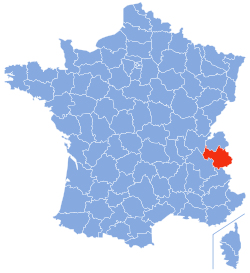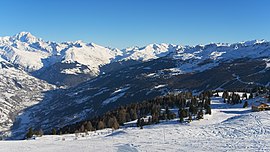Savoie
Savouè (Arpitan) | |
|---|---|
From top down: Tresserve on the Lac du Bourget, La Plagne, prefecture building in Chambéry, Les Arcs ski station, Vanoise National Park, Moûtiers Cathedral and Tignes | |
|
| |
 Location of Savoie in France | |
| Coordinates: 45°35′N 6°20′E / 45.583°N 6.333°E | |
| Country | France |
| Region | Auvergne-Rhône-Alpes |
| Prefecture | Chambéry |
| Subprefectures | Albertville Saint-Jean-de-Maurienne |
| Government | |
| • President of the Departmental Council | Hervé Gaymard[1] (LR) |
| Area | |
• Total | 6,028 km2 (2,327 sq mi) |
| Elevation | 1,595 m (5,233 ft) |
| Highest elevation | 3,855 m (12,648 ft) |
| Lowest elevation | 208 m (682 ft) |
| Population (2021)[2] | |
• Total | 442,468 |
| • Rank | 57th |
| • Density | 73/km2 (190/sq mi) |
| Time zone | UTC+1 (CET) |
| • Summer (DST) | UTC+2 (CEST) |
| Department number | 73 |
| Arrondissements | 3 |
| Cantons | 19 |
| Communes | 273 |
| ^1 French Land Register data, which exclude estuaries and lakes, ponds and glaciers larger than 1 km2 | |
Savoie (pronounced [savwa]; Arpitan: Savouè or Savouè-d'Avâl; English: Savoy /səˈvɔɪ/) is a department in the Auvergne-Rhône-Alpes region, Southeastern France. Located in the French Alps, its prefecture is Chambéry. In 2019, Savoie had a population of 436,434.[3]
Together with Haute-Savoie, it is one of the two departments of the historical region of Savoy; the Duchy of Savoy was annexed by France in 1860, following the signature of the Treaty of Turin. The area is known for its numerous ski resorts and contribution to French cuisine, with culinary specialities such as fondue savoyarde, tartiflette, génépi, as well as various sorts of saucisson.
- ^ "Répertoire national des élus: les conseillers départementaux". data.gouv.fr, Plateforme ouverte des données publiques françaises (in French). 4 May 2022.
- ^ "Téléchargement du fichier d'ensemble des populations légales en 2021" (in French). The National Institute of Statistics and Economic Studies. 28 December 2023.
- ^ Populations légales 2019: 73 Savoie, INSEE








